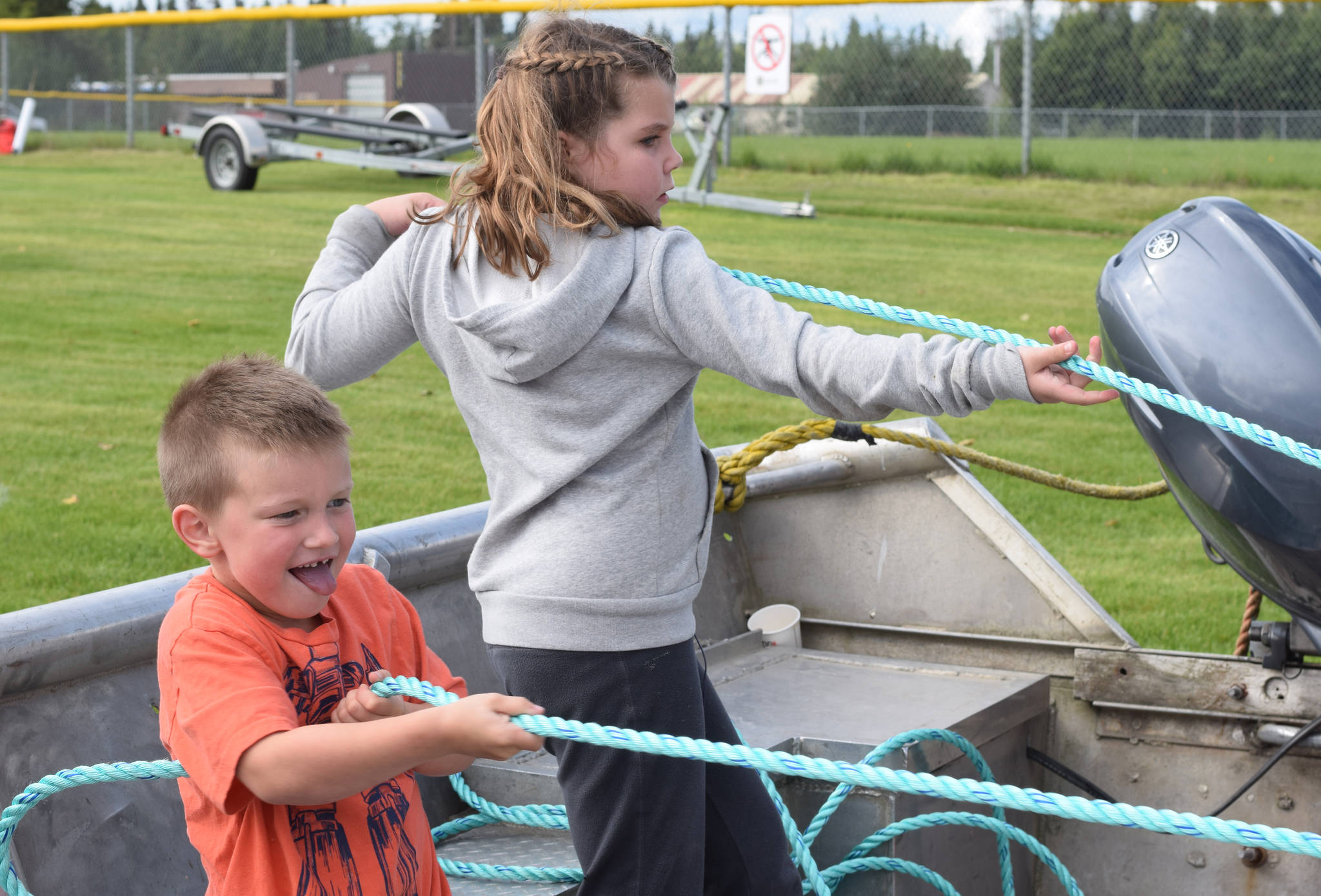While celebrating the industries that fuel the Kenai Peninsula, Gov. Bill Walker stressed the importance of diversifying Alaska’s commerce.
“You look at the career opportunities in this state, as far as the resources in the ground, and you have to ask what we are doing to develop our resources and our careers,” Walker said in an interview during the annual Industry Appreciation Day, held on Kenai Park Strip on Saturday.
The event brought together community members and those involved in the oil and gas, commercial fishing, tourism and medical industries to recognize the contributions of local businesses and individuals.
“I look out today and see the celebration of industry and, you know, no one in Alaska does it like you do,” Walker said to the crowd, which was spread out among the park, enjoying free barbecue and a salmon bake, playing games or talking to political candidates.
In the face of a changing economy, though, Walker is optimistic that creativity and innovation can replace the security once provided by the booming oil and gas industry, which makes up a third of Alaska’s economy, according to a recent report created for the Alaska Oil and Gas Association trade group by McDowell Group, an Anchorage-based economic consulting firm.
“I think we’re catching up with the opportunities,” Walker said. “Sometimes, when the money sort of rolls in and there is plenty of money, creativity isn’t necessarily on the front burner. Now, it’s on the front burner and we have the right kind of attitude and perceptiveness to those opportunities.”
The state’s oil production has been on a steady path downward from its peak of 2 million barrels a day in 1988 to today’s average of about 500,000 barrels a day. The decline in production is also mirrored by a decline in Alaska’s revenue from oil, which has dropped from $9.8 billion in 2012 to $1.6 billion in 2016, according to the report.
Decline isn’t exclusive to the oil and gas industry. According to the Alaska Fish and Game website, as of Aug. 22, the 2017 commercial harvest for all species of salmon were smaller in 2017 than 2016 “due to the lower overall projection of sockeye salmon in the Upper Cook Inlet and closures of two regular fishing periods for the East Side Set Net Fleet in the Upper Subdistrict and the Drift Fleet in the Central District. The smaller projection requires staff to manage all stocks more conservatively to best meet escapement goals into the fishery.”
The peninsula’s medical industry is healthy, but the Central Peninsula Hospital has been preparing itself for reductions as health care reform puts stress on revenues, said Chief Financial Officer Spindler in a presentation to the Kenai Peninsula Borough Assembly in May. Spindler also reported that the hospital’s revenue in the first three quarters of Fiscal Year 2017 was only $1.75 million, a 91 percent drop from the $20.2 million in net income brought in during the first three quarters of FY2016
The tourism industry, though has been steadily increasing in small increments, with a 1.7 percent increase from 2015 to 2016 in taxable sales for primarily tourism businesses, which was about $175 million in 2016 according to the Alaska Travel Industry Association.
“Alaska is really untapped in many areas,” Walker said. “There are just so many things that we don’t do. … We have depended upon one commodity for a long time. It’s still very important, no question about that, but there are so many other things that can happen,” Walker said.
Walker pointed to several industries where he’d like to see growth, including mariculture, agriculture and communication.
In May, the Alaska Mariculture Task Force, established by Walker in 2016, announced tangible indications of growth after seeing applications for over 1,000 acres of new oyster and kelp farms and the emergence of seaweed farming. The Alaska Legislature also advanced four bills supporting the responsible growth of Alaska’s mariculture industry, which does not include fisheries.
“I met a young couple in Juneau that’s making kelp salsa,” Walker said. “They are taking the kelp out of the ocean, bringing it in and making the kelp salsa. There are just so many things that we don’t do and there is a lot of mariculture opportunities.”
Agriculturally, Walker said he would like to see businesses like peony farms in Homer or the smaller greenhouses throughout the state continue to grow and thrive.
“Whether it’s big, small, we just have to be more diversified,” Walker said.
Beyond natural resources, the governor said he knows the importance of digital resources throughout the state and the need to have all of Alaska connected through telecommunications.
“We are behind the curve on what we should be able to do with communications,” Walker said. “… We need to make sure that the infrastructure is available for that. Communication is important.”
Alaska is lacking bandwidth and connectivity, Walker said, but he is confident in projects such as the OneWeb satellite constellation, which is a proposed constellation of nearly 650 satellites that would provide global Internet broadband service to consumers in this decade.
“I think there is a little bit of an awakening happening in Alaska that we need to think about things a little differently,” Walker said.
Reach Kat Sorensen at kat.sorensen@peninsulaclarion.com

